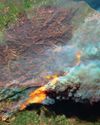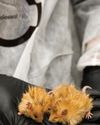試す 金 - 無料
BY ENDURANCE, WE CONQUER
Muse Science Magazine for Kids
|July/August 2023
More than a century after it was lost, scientists discover Ernest Shackleton's ship Endurance.

In the control room aboard the vessel S.A. Agulhas II, Chad Bonin and a team of scientists stared intently at a screen. They were watching data pour in from the autonomous underwater vehicle (AUV) that scanned the depths of the Weddell Sea off the coast of Antarctica. The underwater drone had been running day and night for nearly two weeks. It was searching for what many thought would be too difficult to locate the Endurance. This lost ship had been captained by the legendary explorer Ernest Shackleton. It had been crushed by shifting ice floes over a century ago, after getting trapped in the Weddell Sea. Remarkably, Shackleton and his crew all managed to escape.
Now, after battling blizzards, drifting sea ice, and below-freezing temperatures, the Endurance22 Expedition was nearly out of time. In a few days, they had to return home.

Despite the approaching deadline, the team refused to give up hope. Bonin was the AUV supervisor for the expedition. "Every day I would walk on deck and say, "Today's the day," he told the website Reach the World. Then, on March 5, 2022, the team caught sight of what appeared to be a ship. "My first reaction was-Hah! We found it!" he said.

Before celebrating, the team needed evidence. The AUV was called back to the S.A. Agulhas II, where it was equipped with a high-resolution camera. Returning to the shipwreck, the drone captured detailed images of the sunken vessel. The 144-foot (44-m) wooden structure was found upright, resting 9,842 feet (3,008 m) below the surface of the sea. Indeed, it was the Endurance, in nearly perfect condition. It was the first time anyone had seen the ship in more than 106 years.
このストーリーは、Muse Science Magazine for Kids の July/August 2023 版からのものです。
Magzter GOLD を購読すると、厳選された何千ものプレミアム記事や、10,000 以上の雑誌や新聞にアクセスできます。
すでに購読者ですか? サインイン
Muse Science Magazine for Kids からのその他のストーリー

Muse Science Magazine for Kids
ANIMAL FIREFIGHTER TO THE RESCUE
Can animals help manage the risks of deadly wildfires?
3 mins
Muse July 2025: The Story Behind Wildfires

Muse Science Magazine for Kids
FIRE DANGER
WHY THE RISK OF WILDFIRES KEEPS GROWING
4 mins
Muse July 2025: The Story Behind Wildfires

Muse Science Magazine for Kids
The Miller NEW Normal
WHAT TODAY’S WILDFIRES TELL US ABOUT OUR FUTURE
8 mins
Muse July 2025: The Story Behind Wildfires

Muse Science Magazine for Kids
WOMEN AND FIREFIGHTING: A GOOD FIT
Jessica Gardetto is a firefighter. Her father was, too. “I grew up with my dad coming home smelling like wildfire and covered in soot,” she says.
1 min
Muse July 2025: The Story Behind Wildfires

Muse Science Magazine for Kids
What is happening on your fingertips when they get all wrinkly in a hot tub?
—Felix G., age 10, Montana
1 mins
Muse July 2025: The Story Behind Wildfires

Muse Science Magazine for Kids
WHEN the SMOKE CLEARS
THE LINGERING EFFECTS OF THE RECENT PACIFIC PALISADES AND ALTADENA EATON FIRES
6 mins
Muse July 2025: The Story Behind Wildfires

Muse Science Magazine for Kids
PICKING TEAMS
Keep it fair with a strategy that relies on geometry.
2 mins
Muse July 2025: The Story Behind Wildfires

Muse Science Magazine for Kids
SHAN CAMMACK
WILDLIFE BIOLOGIST AND FIRE SAFETY OFFICER
3 mins
Muse July 2025: The Story Behind Wildfires

Muse Science Magazine for Kids
Scientists Create Mice With Woolly Mammoth-Like Fur
RESEARCHERS AT A COMPANY IN TEXAS ARE WORKING TO CREATE A LIVING ANIMAL THAT RESEMBLES THE EXTINCT WOOLLY MAMMOTH. Recently, they produced mice with traits of the large mammal. The mice all have coats with mammoth-like fur, and some of the small mammals also have genes that help them store fat. Both features would help the animals survive in the cold Arctic, where the woolly mammoth once lived.
1 min
Muse July 2025: The Story Behind Wildfires

Muse Science Magazine for Kids
Cool Sunshade Added to the Nancy Roman Space Telescope
THE NANCY ROMAN SPACE TELESCOPE IS A NEW TELESCOPE THAT NASA IS BUILDING AND WILL LAUNCH INTO SPACE, LIKELY IN EARLY 2027.
1 min
Muse July 2025: The Story Behind Wildfires
Translate
Change font size

